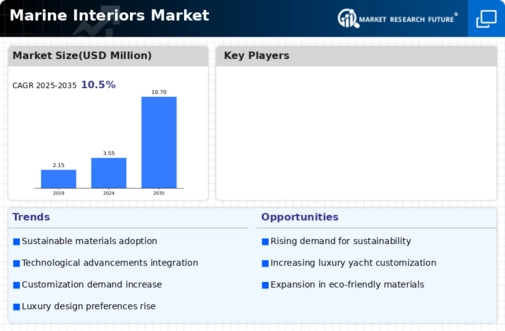Market Analysis
In-depth Analysis of Marine Interiors Market Industry Landscape
Cruise ships, in their quest to provide passengers with a comfortable and luxurious experience, rely on a variety of interior components and solutions. The Cruise Lines International Association (CLIA) projects a significant increase in the global cruise industry, estimating that it will carry around 30 million passengers by 2022, up from 28.5 million in 2018. This surge in the cruise sector is generating a heightened demand for innovative and tailored interior solutions that cater to the specific needs and preferences of cruise passengers.
To meet these evolving demands, marine interiors companies are actively engaged in the development of novel materials, designs, and technologies. The goal is to not only enhance the overall passenger experience but also to optimize efficiency within cruise ship interiors. An additional dimension to this evolution is the integration of smart technology on cruise ships. This involves incorporating intelligent systems to improve cabin comfort, automate functions, and provide personalized services to passengers. These technological advancements contribute to making cruising a more appealing and comfortable experience, thereby fostering increased demand for cruises and subsequently, driving the need for advancements in marine interiors.
A noteworthy example of this technological integration is Norwegian Cruise Line's introduction of the "Cruise Norwegian" mobile app in 2020. This app empowers passengers to seamlessly book and manage their entire cruise experience directly from their smartphones. In addition to the convenience of mobile check-in, the app offers contactless features such as keyless stateroom entry, exemplifying the industry's commitment to leveraging technology for the benefit of passengers.
The marine industry is also navigating towards sustainability in response to heightened environmental concerns and regulatory pressures. The push for eco-friendly practices is significantly influencing the materials used in marine interiors. Cruise ship operators, recognizing the imperative to reduce their environmental impact, are increasingly turning to sustainable and eco-friendly materials. This shift includes the adoption of recyclable, biodegradable, and energy-efficient materials to diminish the industry's overall environmental footprint.
An illustrative case is Royal Caribbean's commitment in 2019 to eliminate single-use plastics from its fleet by 2020. In pursuit of this goal, the company implemented sustainable alternatives such as bamboo straws, wood coffee stirrers, and the use of paper bags and cups as substitutes for their plastic counterparts. This strategic move aligns with the broader industry trend towards embracing sustainability in marine interiors, reflecting a commitment to responsible environmental practices.
In conclusion, the cruise industry's upward trajectory is fostering a demand for sophisticated and customizable interior solutions that cater to the discerning preferences of passengers. Simultaneously, the integration of smart technology is redefining the cruise experience, making it more appealing. Furthermore, the industry's growing emphasis on sustainability is driving the adoption of eco-friendly materials. As cruise operators aim to strike a balance between luxury and environmental responsibility, the evolution of marine interiors is becoming a pivotal aspect of the industry's future.




Leave a Comment